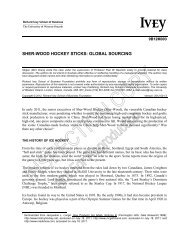foundation of canada asia pacific - Content Tagged with
foundation of canada asia pacific - Content Tagged with
foundation of canada asia pacific - Content Tagged with
You also want an ePaper? Increase the reach of your titles
YUMPU automatically turns print PDFs into web optimized ePapers that Google loves.
OVERVIEW<br />
1<br />
<strong>asia</strong> in convalescence<br />
7<br />
Little more than two years after Asia slid into its worst recession <strong>of</strong> modern times, the<br />
economies at the epicentre <strong>of</strong> the turmoil seem to be recovering strongly. Led by South<br />
Korea and Thailand, all had returned to a growth path by the end <strong>of</strong> 1999. The economic<br />
turnaround from the dark days <strong>of</strong> late 1997 and early 1998 came faster than almost<br />
anyone had imagined possible, though there is a lot <strong>of</strong> ground to make up to recoup<br />
the losses incurred in the downturn. There is still uncertainty clouding the progress<br />
<strong>of</strong> Japan and China, each grappling as they are <strong>with</strong> problems only peripherally caused<br />
by the Asian recession. But, overall, there is widespread optimism that Asia is well on<br />
the way to a full recovery. Some <strong>of</strong> this optimism may be a little premature, however.<br />
The speed <strong>of</strong> the apparent recovery has dulled the sense <strong>of</strong> urgency to the need to<br />
undertake further fundamental economic reforms. Reluctance to make painful changes<br />
has seen the restructuring <strong>of</strong> financial systems and the rationalization <strong>of</strong> industry<br />
move ahead more slowly than is suggested by the rapid recovery in output, much <strong>of</strong> which<br />
is supported by heavy government deficit spending. Fundamental reform is still needed.<br />
The worst may be over, but the economies <strong>of</strong> Asia still face a long period <strong>of</strong> convalescence<br />
(as we explain in Chapter 2, A Year in Review).<br />
For Canada, the recovery in our economic relationship <strong>with</strong> Asia has hardly begun. For<br />
Canadian business, “Asia” largely means Japan and China. As long as the Japanese economy<br />
is struggling and Chinese prospects remain uncertain, our exports to Asia will continue<br />
to flounder. Imports, on the other hand, are booming, providing a boost to sectors <strong>of</strong> the<br />
economy like transport and retailing, to <strong>of</strong>fset the loss <strong>of</strong> export business in others. There<br />
has also been a benefit to Canada through lower inflation and hence interest rates in the<br />
US flowing from the Asian crisis. The negative impact <strong>of</strong> the Asian downturn on Canada<br />
was limited to a few industries in specific regions, notably western Canada’s resource<br />
industries. In the same way, the effect <strong>of</strong> Asia’s recovery on Canada will also be limited<br />
and geographically confined. However, it would be wrong to take comfort from this<br />
limited impact, because, rather than reflecting an area <strong>of</strong> strength in Canada’s economy,<br />
it defines our small and shrinking economic involvement <strong>with</strong> Asia.<br />
For a decade or more, as globalization eroded international barriers to the flow <strong>of</strong> goods,<br />
services and capital, Canadian business has been transfixed by the allure <strong>of</strong> the American<br />
market. By most measures, our stake in globalization has been extensive, though largely



